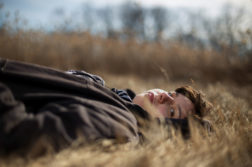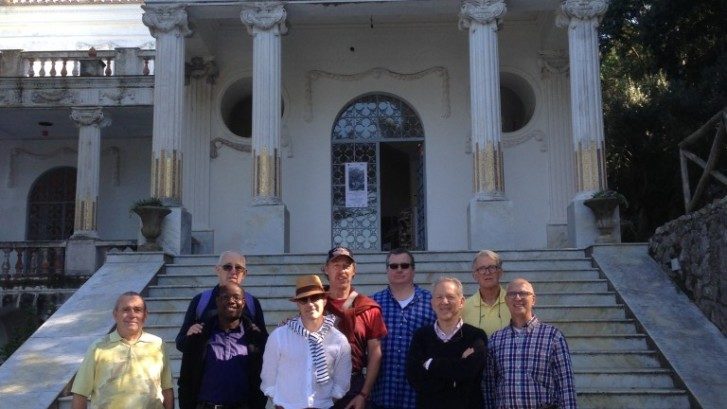
This week brought Oscar Wilde Tours a big honor: we won the Travvy silver award for best LGBT tour operator. Pretty amazing, when you think that we are just starting our second season! I think and hope it means that people in the travel industry find our concept exciting—gay travel focusing on gay history and art— and also that they are hearing good things about our tours in New York, Ireland, and Italy. As a result of the prize, I’ve been thinking about what I have learned in the last 2 years, while starting this company. I’ve been wondering which of all the things I’ve discovered in the cities are my favorites: the things that resonate with my imagination and have enlarged my sense of gay history.
Oscar Wilde’s New York
Certainly, I have found that there are fascinating bits of evidence for gay history in all the cities where we do tours—New York, London, Paris, Rome, Florence, Athens. Perhaps my favorite example of all comes from Greenwich Village. There is a shabby little building with a green 1970s facade on Broadway, just below the Northwest corner of Union Square. It’s just two doors from the much grander Decker Building, where (more gay history!) Andy Warhol’s Factory was in the late 60s and 70s, when Andy was shot and Paul Morrissey made all of his silly-sexy movies. The squat little building looks like nothing—but it’s even cooler. In 19th century photos of it, when it was much prettier, you can see the name ‘Sarony’ written across the third floor windows, presumably in gold. Because this was the photo studio of Napoleon Sarony, where he took the famous series of photos of Oscar Wilde dressed in the tights, velvet, and fur etc. with which he wowed or amused his American audiences—the photos which still appear in poster shops. Who would have thought that they were taken in New York City? That’s the kind of thing I’ve been learning for two years.
Rosa Bonheur’s Paris
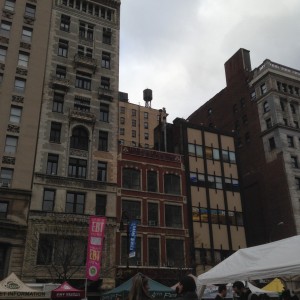
Another place where I have made a lot of great discoveries is Paris’ famous monumental cemetery, Père Lachaise. Like most Wilde fans, I had been to Wilde’s grave a number of times, and I already knew some other famous gay graves in the cemetery, such as the joint grave of Gertrude Stein and Alice Toklas. But on exploring the cemetery with friends from a Paris gay group, I found so much more gay history. Just as an example, there is the tomb of the painter Rosa Bonheur (1822-1899). Bonheur, a famous animalière, is the creator of the huge and impressive painting of “The Horse Fair” that dominates the back wall of the Metropolitan Museum’s 19th century collection. Most people, I think, ignore her today, but in the 19th century, she was a big deal: she won gold medals at the Paris Salon and was a favorite painter of people like Cornelius Vanderbilt (who donated “The Horse Fair” to the Met) and Queen Victoria. But though Queen Victoria famously did not believe in Lesbians, that is what her favorite painter was. She lived for many years with her girlfriend Nathalie Micas and the girlfriend’s mother, and later, when her girlfriend died, an American woman named Anna Klumpke moved in to take care of her studio, and they lived together for the rest of Bonheur’s life. And they are all buried together—Bonheur, both girlfriends and the first girlfriend’s mother—in a huge tomb in Père Lachaise.

The Sacred Band’s Greece
Of course as a Classicist many of my favorite things have to do with the ancient world, and its very different view(s) of sexuality. Unsurprisingly, I already knew Greece and Italy pretty well before this year. But still, there have been discoveries. I had for instance never seen the Lion Monument of Chaironeia before, because it’s a little out of the way, and no-one had ever said I absolutely should go see it. But now that I have, I can’t think why not: how could anyone who cares about the gay past not want to see it? The monument (largely intact) commemorates a regiment, called the Sacred Band, whose battle line was arranged in lover/beloved pairs—ancient Greek male-male couples! It was the crack regiment of the late Classical period, and this is what Phaedrus in Plato’s Symposium is talking about when he says that an army consisting of lovers and beloveds could defeat the whole world. It is, in short, the best-preserved monument to ancient Greek male-male love, and it is referred to in the most influential work in the whole gay tradition. So….how much more gay-historical could you get than that? It also, of course, reminds one that the Greeks saw male-male love differently from any modern culture: they thought that male plus male meant twice as male, so they associated at least some kinds of male-male love with courage and loyalty in battle, their favorite virtues.
Antinous’ Rome
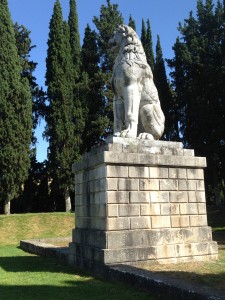
Another thing that reminds you of male-male love’s different status in the ancient world is the relationship between the Emperor Hadrian and his boy “favorite” Antinous, whom Hadrian made into a god when he died, presumably a suicide, by falling into the Nile at age 19. I have become interested in this as a scholar this year, because I see it as an interesting combination of Greek and Roman culture, which is typical of Hadrian’s “style” (or policy/propaganda)—and also, because it is amazing how little scholarship there is on this fascinating, unusual, and unusually well-documented relationship—typical of the homophobia (or gay panic) of my academic field. Anyway, what I found while exploring is how amazingly many pieces of evidence there are for this relationship in the city of Rome (you can see a blog post I did about this for The Gay and Lesbian Review). There are busts or statues of Antinous in every Roman museum, because they were found all over the city, and there are several still in public as well. The coolest of all is the obelisk in the Villa Borghese behind the Belveder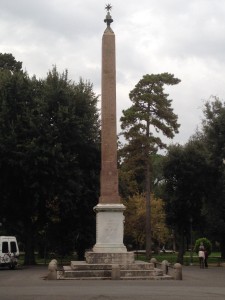 e on the Pincio, which comes from a temple of Antinous, possibly the one at the Imperial villa in Tivoli, and is covered with prayers to the divine Antinous—possibly composed by the Emperor himself! Again, this shows us how differently the Ancients viewed male-male love: imagine a modern ruler creating a cult to his dead male lover and writing public prayers to him! It was unusual in the ancient world too, but not impossible: Hadrian was probably the most successful emperor in all of Roman history.
e on the Pincio, which comes from a temple of Antinous, possibly the one at the Imperial villa in Tivoli, and is covered with prayers to the divine Antinous—possibly composed by the Emperor himself! Again, this shows us how differently the Ancients viewed male-male love: imagine a modern ruler creating a cult to his dead male lover and writing public prayers to him! It was unusual in the ancient world too, but not impossible: Hadrian was probably the most successful emperor in all of Roman history.
In any case, I could go on and on. There are a lot of great places and artworks that speak to us about gay history in the world’s great cities—and in many of the great museums—and in organizing Oscar Wilde Tours’ tours of New York, London, Paris, Italy and Greece, I have learned more about them than even I thought possible. So come on one of Oscar Wilde Tours’ tours in 2016, and let us share out discoveries with you!





